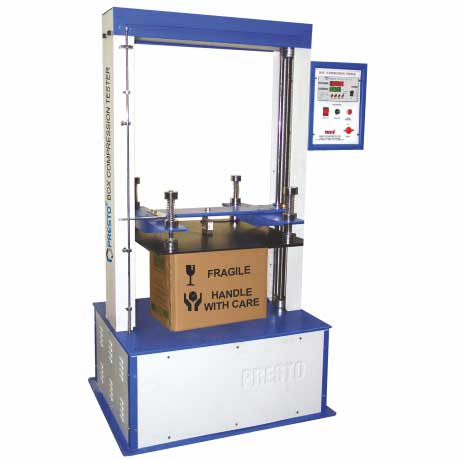Compression testing is a mechanical test in which a material or product responds to forces that push, compress, flatten a specimen. Compression testing is a basic mechanical test similar to tension and bending testing. Compression testing characterizes the strength and stiffness of materials and products under compressive loading. These tests are usually performed by applying pressure to the specimen using special equipment with a platen or testing machine that produces a compressive load. Compression testing is done by an instrument called a compression strength tester.
Compression test
In compression testing, material properties such as stress and strain on the specimen are measured and various calculations are performed. The data are plotted as stress-strain diagrams. Qualities such as compressive strength, yield point, proportional limit, yield point, yield point, and modulus are determined from the data.
Many specimens are placed between two plates or slabs that distribute the applied load over the entire surface area of the two opposite sides of the specimen. The plate is compressed by a compression tester to flatten the sample. The deflection or strain of a sample is measured mechanically or by a flexometer or extensometer.
What is the purpose of compression testing?
The purpose of compression testing is to determine the behavior or response of materials when subjected to compressive loads by measuring fundamental variables such as strain, stress, and deformation. By testing materials under compression, parameters such as compressive strength, yield strength, ultimate strength, elastic limit, and elastic modulus can be determined. By understanding these various parameters and the values associated with a particular material, we can determine if the material is suitable for a particular application or if it will fail under specified loads.
Ultimate compressive strength measurement
Compressive strength testing measures the compressive load or stress a material can withstand before it fails. The shape of the specimen is usually a cube, prism, or cylinder compressed between compression plates or compression plates. Force is measured by a load cell and data is collected by a test controller. These applications use crosshead movement locators to measure displacement between platens. Some materials break at the limit of their compressive strength. Others deform irreversibly, so the deformation limit can be considered as the compressive load limit. Compressive strength measurements are subject to specific test methods and measurement conditions. Characterization of compressive stress-strain properties
In addition to strength, many applications include the characterization of uniaxial stress-strain properties such as compressive modulus, yield strength and elastic limit, proportional limit, yield strength, and yield point. Some testing applications measure hardness or stiffness under compressive loading.
The accuracy of strain measurements depends on the accuracy of the deflection, displacement, or strain sensors that measure the deformation of the specimen. By attaching sensors to the test sample or directly measuring platen-to-platen displacement, tester compliance is eliminated.
Compression testing generally requires short-stroke accuracy sensors that make direct contact with the test sample, rather than relying on readings from a tester or crosshead motion encoder. In many applications, plate-to-plate measurements require averaging three equally spaced displacement sensors to accurately measure the axial deflection.
Compression test application
Compression testing is used to check the quality of various materials based on their properties such as compressive strength, modulus and yield strength. When choosing materials for final products or prototypes, you need to know if they will hold up in real-world use. All materials have a predetermined limit point. So knowing the strength of the material you’re using can alert you if you’re using something that can’t withstand the stress. When choosing composites, metals, rubber, and other raw materials. , a pressure test will help you choose the strongest option available for the job.
Different types of materials and products require different types of fixtures. Thin film specimens require a different fixture than rubber gasket specimens.
Thus, you can understand why using a compression strength tester is important for industries.




